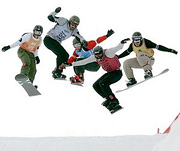What's the worst injury you've suffered while snowboarding? How did you recover? I was constantly tweaking my ankles until my chiropractor said I should get one of the best MRIs possible - one that would scan in 3 mm increments. This detected a bone bruise in my ankle. What we figured out was in certain conditions with high impact, my arch was falling out, which allowed my leg bone to come over on top of my ankle bone, thus bruising it. I had tried numerous taping procedures in the past that did not stop the reoccurring injury to my ankle, but after my chiropractor did a different tape job to hold the arch up, I have yet to injure it. Of course, this took the right chiropractor who also had training in sports rehab.
What do you do to stay in shape (besides practicing tricks and competing)? Right now it just requires lots of stretching. For an aging athlete (33, which is still young), if I did not continue to stretch, I don't believe I could do anything.
Do you follow any sort of a diet, or does anything go for snowboarders? I think this just comes down to the kind of person you are. I can eat anything I want and as much as I want and can never put on any weight. I will say the snowboarding lifestyle does not always allow you to eat as healthy as you need to, especially when you are just getting started and wanting to be a pro rider. More than likely, you are broke because you don't have a good job because you need to be snowboarding every day. Can you say ramen for lunch and ramen for dinner?
 Do you take vitamins, herbs or other supplements? I used to use Advocare systems for strength, recovery and hydration. Hydration is super important as an athlete in high altitude. I myself have a hard time staying hydrated. This requires lots of Powerade (this works the best for me), Emergen-C and Advocare's POS 3 (rehydration system).
Do you take vitamins, herbs or other supplements? I used to use Advocare systems for strength, recovery and hydration. Hydration is super important as an athlete in high altitude. I myself have a hard time staying hydrated. This requires lots of Powerade (this works the best for me), Emergen-C and Advocare's POS 3 (rehydration system).
If you could travel anywhere to snowboard, where would you want to go? I would definitely do heli-riding up in Alaska, no question.
Do you have any advice for people who are thinking about getting into snowboarding, amateur or professional? Surround yourself with the best - the best trainers, coaches, sports physicians and athletes. When you surround yourself with the best, it only elevates your game. This can be applied to anything in life.
Here's an introduction to basic snowboarder lingo:
Half-pipe - A snow-covered, U-shaped, high-sided ramp or runway. It is used to catch air and perform tricks by traveling back and forth from wall to wall.
Indy - Back hand grabs the toe-edge between the bindings.
Ollie - A trick in which the rider springs off the tail of their board and into the air.
Rodeo - A backflip with a spin of at least 180 degrees.
Alley-oop - Any maneuver in the half-pipe where one rotates 180 or more degrees in the uphill direction (i.e., rotating backside on the frontside wall or rotating frontside on the backside wall).
Freestyle - The type of snowboarding which is mostly associated with riding the half-pipe, but may also be used to describe any type of snowboarding which includes tricks and maneuvers.
Tweaked - A term used to describe the emphasis of style in a trick.
Landing fakie - Landing backwards.
Inverted 720 - An inverted aerial where the rider performs a 720-degree rotational flip.
Goofy foot - To ride with the right foot forward.
Dialed-in - Tuned to perfection.
Method Air - The front hand grabs the heel edge, both knees are bent, and the board is pulled up behind the rider. In the half-pipe, the rider's body can become almost parallel with the ground.
Grasser Method - A variation on the method air, performed with the front hand grabbing the heel edge and twisting the board so it faces downhill. The back leg is also boned out. Named after a group of riders from Grass Valley in California.


